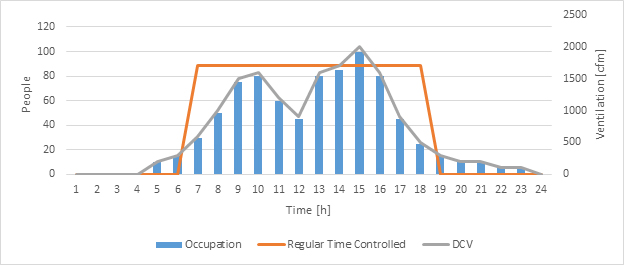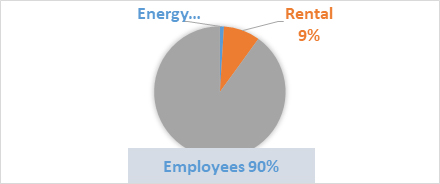HVAC用途でCO₂を計測する理由
HVAC用途におけるCO₂計測
CO₂センサに関して、通常、一般空調(HVAC)は注力するべき用途とは見なされていません。確かに周囲条件は良好な場合がほとんどでしょう。それでもやはり、センサには、信頼性が高く、メンテナンスが容易で、長期的に安定して計測できることが求められます。この記事では、そもそもなぜCO₂の計測が必要なのか、デマンド制御空調(DCV)はどのような仕組みなのかという点を説明してから、CO₂の計測が建物内での健康維持にどのように役立つか、またそれは運用コストにどのように影響するのかといった点を見ていきます。
HVAC用途でCO₂を計測する理由
CO₂を計測する最も一般的な理由はエネルギーを節約することですが、室内空気質(IAQ)が人の健康に直接影響を及ぼすことを示す証拠が増えていることは、健康で生産的な労働環境を維持するうえでCO₂計測が重要になっていることを意味します。特に建物の所有者がDCVの使用している場合やCO₂計測を必要とする認証を求めている場合は、規制への準拠するためにも計測は必要です。
DCVの仕組みとは

上のグラフは、所定の時間に制御される換気とDCVの違いを示しています。青色の棒はオフィスなどの空間に出入りする1日の人数(在室密度)を示し、オレンジ色の線は所定の時間に制御される換気の状況を示しています。この場合、換気は午前7時から午後6時まで制御され、夜間に換気しないことでエネルギーを節約します。灰色の線は、DCVがCO₂計測と連動してどのように機能するかを示しています。室内のCO₂濃度はセンサで計測され、望ましいレベルで濃度を維持できるように新鮮な空気の量が制御されます。新鮮な空気や換気の量は、建物の在室密度によって異なります。
HVAC用途での CO₂センサに関する規制上の考慮事項
HVAC用途に関連する最も重要な規格の1つはASHRAE 189.1 グリーンビルディング(環境配慮型建物)基準です。この基準は精度に関してCO₂センサに厳しい要件を課しており、屋外のCO₂濃度を計測できるセンサを使用するか、地域の統計に基づいて濃度を推定できることを義務付けています。実際には、多くの人が屋外センサを選んでいます。
最も長い歴史を持つ規制の1つは、カリフォルニア州エネルギー委員会のCEC-400-2008-001基準(住宅用および非住宅用建物のエネルギー効率基準)です。LEED v.4 グリーンビルディング基準では、人の出入りがある場所でのCO₂モニタリングに関する2つのクレジットを設け、CO₂計測のクレジットを認定しています。センサの精度、校正間隔およびメンテナンスに関連する要件もあります。メンテナンスは私たちが昨今目にするようになっているものであり、理にかなっています。メンテナンスを要求されなければ、計測しなければならないということはないでしょう。
室内空気質(IAQ)は最近注目され始めた項目です。たとえば、国際ウェルビルディング協会のWELL Building Standard(ウェルビルディング基準)は、主にLEED基準とASHRAE基準に基づいています。現在、焦点は技術的要件から建物に出入りする人の健康へとシフトしています。2010年、世界保健機関は室内空気質ガイドを発行しました。そのガイドには汚染物質のガイドラインが含まれており、それらの潜在的な健康リスクが記載されています。
HVAC計測が建物の運用コストに与える影響
一般的なオフィスビルの運用コストの内訳は、たとえば次のようになります。

建物の総運用コストのうち、エネルギーコストは約1%、賃貸料または資本コストの合計が9%、従業員の賃金が90%です。これは、従業員の健康と生産性が、HVACに関しておそらく最も重要な考慮事項であることを意味します。CO₂計測を利用してHVACシステムを最適化しなければ、生産性の低下によって、非常に大きな部分(90%)が打撃を受ける可能性があります。
CO₂レベルと従業員の生産性の関係
研究によると、CO₂濃度は人の認知能力に大きな影響を及ぼします。ハーバード大学のグループが実施したある研究では、CO₂濃度の変化によって特定のスキルがどのように影響を受けるかが調査されました。その結果、作業するのに健康的なレベルであると考えられる 1,000ppm の濃度レベルでも、危機対応、情報の使用、戦略的思考などのスキルが大幅に損なわれたことがわかりました。
CO₂レベルの上昇は、従業員の学習能力の低下、生産性の低下、不適切な意思決定、間違い、さらには危険な状況をも招く可能性があります。概して、この研究は、良好な室内空気質によって従業員の生産性が大幅に向上し得ることを認めているようです。
このシリーズの次のブログでは、HVAC用途におけるヴァイサラのCARBOCAP®センサ技術の独自の利点を見ていきます。


Comment
//Hans
新規コメントを送信